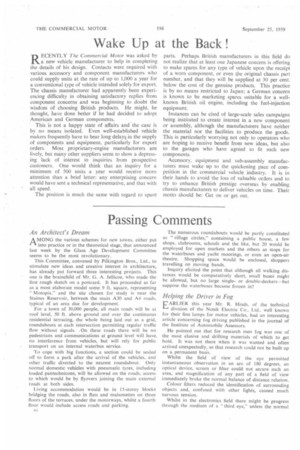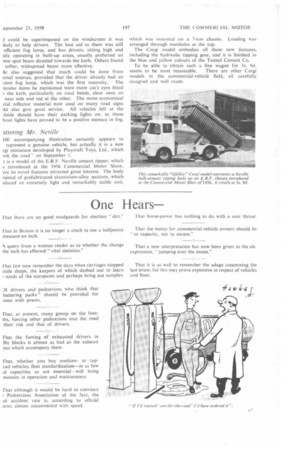Passing Comments
Page 38

Page 39

If you've noticed an error in this article please click here to report it so we can fix it.
An Architect's Dream
A MONG the various schemes for new towns, either put " into practice or in the theoretical stage, that announced last week by the Glass Age Development Committee seems to be the most revolutionary.
This Committee, convened by Pilkington Bros., Ltd., to stimulate new ideas and creative interest in architecture, has already put forward three interesting projects. This one is the brainchild of Mr. G. A. Jellicoe, who made the first rough sketch on a postcard. It has proceeded as far as a most elaborate model some 9 ft. square, representing " Motopia," and the site chosen for study is near the Staines Reservoir, between the main A30 and A4 roads. typical of an area due for development.
For a town of 30,000 people, all main roads will be at roof level, 50 ft. above ground and over the continuous residential terracing, the whole being laid out as a grid, roundabouts at each intersection permitting regular traffic flow without signals. -On these roads there will be no pedestrians and communications at ground level will have, no interference from vehicles, but will rely for public transport on an internal waterbus service.
To cope with big functions, a section could be sealed off to form a park after the arrival of the vehicles, and other traffic diverted to the nearest roundabout. Only normal domestic vehicles with pneumatic tyres, including loaded pantechnicons, will be allowed on the roads, access to which would be by flyovers joining the main external roads at both sides.
Living accommodation would be in 15-storey blocks bridging the roads, also in flats and maisonettes on three floors of the terraces, under the motorways, whilst a fourth floor would include access roads and parking.
134 The numerous roundabouts would be partly constituted as "village circles," containing a public house, a few shops, clubrooms, schools and the like, but 20 would be employed for open markets and the others as stops for the waterbuses and yacht moorings, or even an open-air theatre. Shopping space would be enclosed, shoppers travelling on moving bands.
Inquiry elicited the point that although all walking distances would be comparatively short, small buses might be allowed, but no large singleor double-deckers—but suppose the waterbuses became frozen in?
Helping the Driver in Fog
ARLIER this year Mr. R. Hinds, of the technical division of the Notek Electric Co.. Ltd.. well known for their fine lamps for motor vehicles, had an interesting article concerning fog driving published in the journal of the Institute of Automobile Assessors.
He pointed out that for research men fog was one of the most elusive and drifting materials of which to get hold. It was not there when it was wanted and often arrived unexpectedly, so that research could not be built up on a permanent basis.
Whilst the field of view of the eye permitted instantaneous observation in an arc of 180 degrees, an optical device, screen or filter could not secure such an area, and magnification of any part of a field of view immediately broke the normal balance of distance relation.
Colour filters reduced the identification of surrounding objects and, confused with other lights, caused much nervous tension.
Whilst in the electronics field there might be progress through the medium of a "third eye," unless the normal could be superimposed on the windscreen it was ikely to help drivers. The best aid to them was still efficient fog lamp, and bus drivers, sitting high and stly operating in built-up areas, usually preferred an !nse spot beam directed towards the kerb. Others found softer, widespread beam more effective.
le also suggested that much could be done from !mai sources, provided that the driver already had an :lent fog lamp, which was the first necessity. The ticular items he mentioned were more cat's eyes fitted ) the kerb, particularly on road bends, clear ones on near side and red at the other. The more economical cial reflector material now used on many road signs iId also give good service. All vehicles left at the dside should have their parking lights on, as those hout lights have proved to be a positive menace in fog.
lttering Mr. Neville
HE accompanying illustration certainly appears to represent a genuine vehicle, but actually it is a new rgi miniature developed by Playcraft Toys, Ltd., which )ok the road on September I.
t is a model of the E.R.F. Neville cement tipper, which s introduced at the 1956 Commercial Motor Show, ere its novel features attracted great interest. The body isisted of prefabricated aluminium-alloy sections, which iduced an extremely light and remarkably stable unit, which was mounted on a 7-ton chassis. Loading was arranged through manholes at the top.
The Corgi model embodies all these new features, including the hydraulic tipping gear, and it is finished in the blue and yellow colours of the Tunnel Cement Co.
To be able to obtain such a fine wagon for 5s. 9d.
seems to be most reasonable. There are other Corgi models in the commercial-vehicle field, all carefully designed and well made.




















































































































